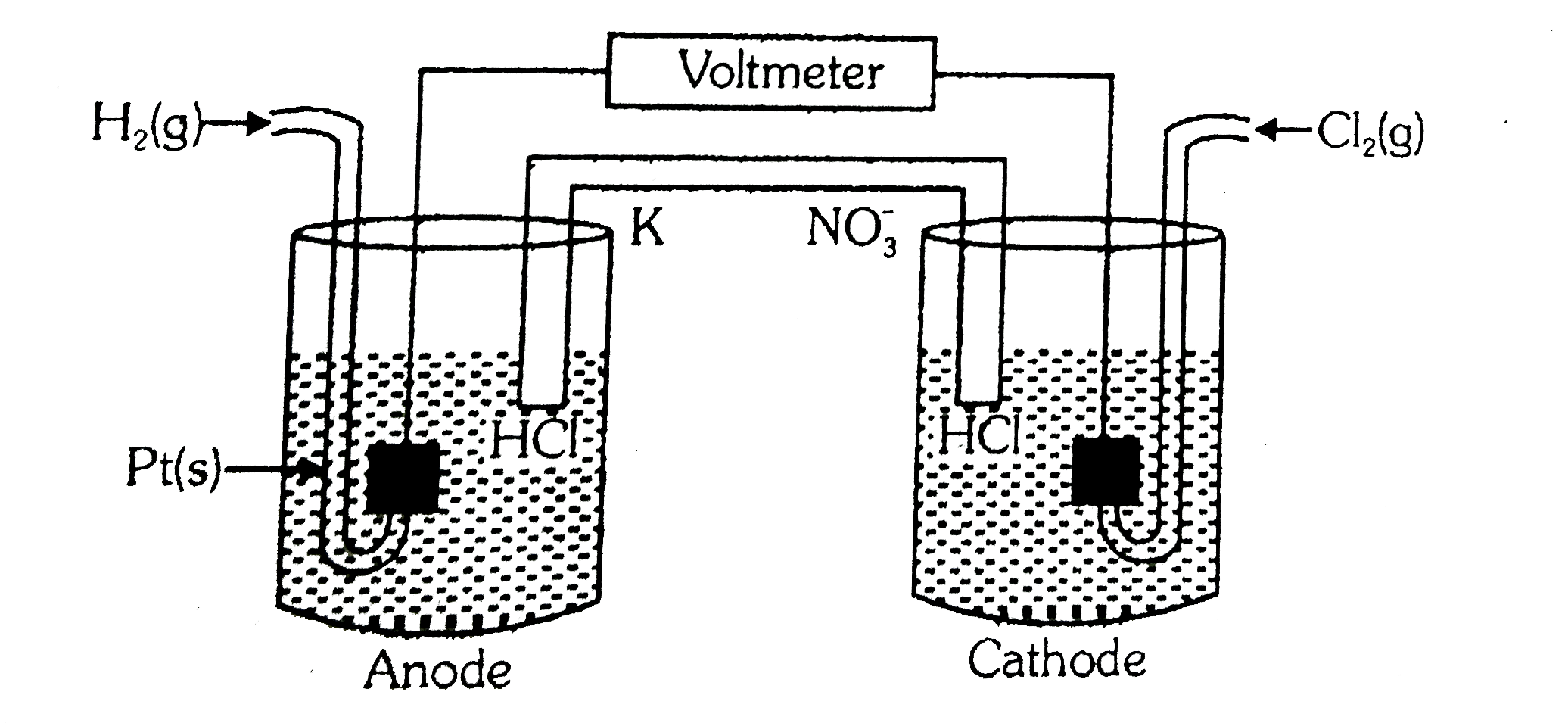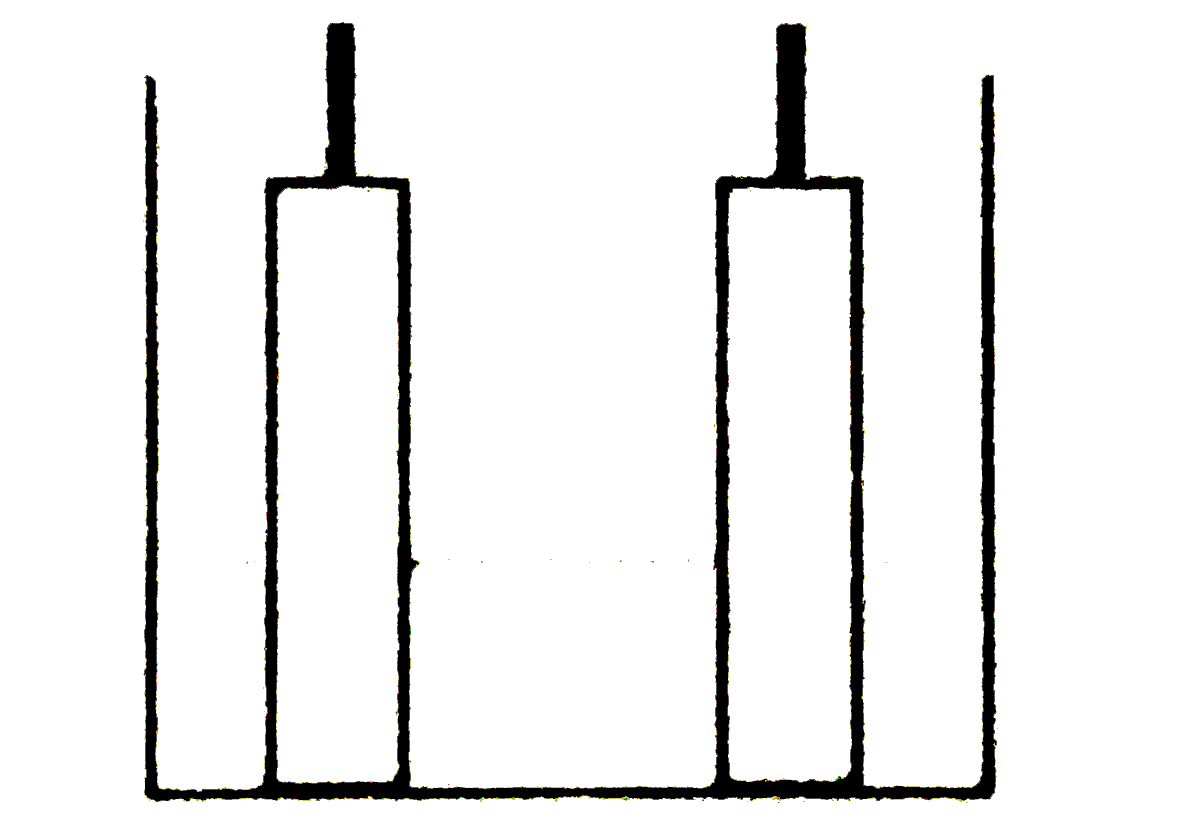Complete Solutions to Advanced Level Problems of chapter ELECTROCHEMISRY of Class 12 book with complete answers and questions
| Class 12 | CHEMISTRY |
| Chapter | ELECTROCHEMISRY |
| RESONANCE | Advanced Level Problems |
| Number Of Questions | 88 |
| Academic Year | 2023-24 |
How much will the reduction potential of a hydrogen electrode change when its solution initially at `pH=0` is neutralized to `pH=7` ?
01:27View SolutionThe standard electrode potentials (reduction) of `Pt//Fe^(3+),Fe^(+2)` and `Pt//Sn^(4+),Sn^(+2)` are `+0.77V` and `0.15V` respectively at `25^(@)C`. The standard `EMF` of the reaction `Sn^(4+) +2Fe^(2+) rarr Sn^(2+) +2Fe^(3+)` is
03:09View SolutionAn acidic solution of copper (II) sulphate containing some contaiminations of zinc and iron (II) ions was electrolysed till all the copper is deposited. If electrolysis is further continued for sometime, the product liberated at cathode is
01:57View SolutionAcetic acid is titrated with NaOH solution. Which of the following statement is correct for this titration?
01:33View SolutionWhich statement is correct?
03:02View SolutionDuring the electrolysis of 0.1 M `CuSO_(4)` solution using coppepr electrodes, a depletion of `[Cu^(2+)]` occurs near the cathode with a corresponding excess near the anode, owing to inefficient stirring of the solution. If the local concentration of `[Cu^(2+)]` near the anode and cathode are respectively 0.12 M and 0.08 M, calcualte the back emf developed. Temperature = 298 K.
06:22View SolutionConsider the following Galvanic cell:-

By what value the cell voltage when concentration of ions in anodic and cathodic compartments both increased by factor of 10 at 298K:04:01View Solution`Pt|Cl_(2)(P_(1)atm)|HCl(0.1M)|Cl_(2)(P_(2)atm)|Pt`, cell reaction will be spontaneous if
View Solution`Pt |{:((H_(2))),(1atm):}:| pH = 2:|:|:pH =3 |:{:((H_(2))Pt),(1atm):}:|`. The cell reaction for the given cell is:-
01:53View SolutionIn the given figure the electrolytic cell contains `1L` of an aqueous `1M` Copper `(II)` sulphate solution. If `0.4 ` mole of electrons passed through of cell, the concentration of copper ion after passage of the charge will be
 02:11View Solution
02:11View SolutionBy how much will the potential of half-cell `Cu^(2+)|Cu` change if the solution is diluted to 100 times at 298K?
02:33View SolutionWhich of the following facts is not truegt
03:26View SolutionEquivalent conductance of 1M `CH_(3)COOH` is `10ohm^(-1) cm^(2) "equiv"^(-1)` and that at inifinite dilution is 200 `ohm^(-1) cm^(2) "equiv"^(-1)`. Hence, % ionisation of `CH_(3)COOJ` is:
01:26View SolutionAdding powdered Pb and Fe to a solution containing 1.0 M each of `Pb^(2+)` and `Fe^(2+)` ions would result into the formation of:
03:06View SolutionCost of electricity for the production of X litre `H_(2)` at STP at cathode is Rs. X, then cost of electricity for the production of X litre `O_(2)` gas at STP at anode will be :(assume 1 "mole" of electrons as one unit of electricity)
03:21View SolutionThe reaction :
`Zn(s) + 2AgCl(g) rightarrow ZnCl_(2)(aq) + 2Ag(s)`
occurs in the cell `Zn|ZnCl_(2)` (1M solution), AgCl(s) | Ag. The number of Faradays required from the external source for this reaction to occur in the cell is:02:10View SolutionIf the pressure of hydrogen gas is increased from 1 atm. To 100 atm, keeping the hydrogen ion concentration constant at 1 M, the reduction potential of the hydrogen half cell is at `25^(@)C` will be
View SolutionThe equilibrium `Cu^(+2)(aq)+Cu(s) hArr2Cu^(+)` established at `20^(@)C` corresponds to `([Cu^(+2)])/([Cu^(+)])=2.02xx10^(4+)`. The standard potential . `E_(Cu^(+2).Cu)^(0)=0.33` volt at this temperature . What is the standard potential `E_(Cu//Cu^(+))^(0)`?
02:32View Solution
The `E^(@)` in the given figure isView SolutionWhat is the cell entropy change `(` in `J K ^(-1))` of the following cell `:`
`Pt(s)|underset(p=1atm)(H_(2)(g))|CH_(2)underset(0.1M)(COOH,HCl)|underset(0.1M)(KCl(aq))|Hg_(2)Cl_(2)(s)|Hg`
The `EMF` of the cell is found to be `0.045 V` at `298K` and temperature coefficient if `3.4xxx10^(-4)V K^(-1)`
`(` Given `:K_(a(CH_(3)COOH))=10^(-5)M)`02:17View Solution`Na-` amalgam is prepared by electrolysis of `NaCl` solution using liquid `Hg` as cathode . How long should the current of `10 amp`. Is passed to produce `10% Na-Hg` on a cathode of `10gm Hg`. ( atomic mass of `Na=23)`.
03:09View SolutionZn amalgam is prepared by electrolysis of aqueous `ZnCl_(2)` using Hg cathode (9gm) How much current is to be passed through `ZnCl_(2)` solution for 1000 seconds to prepare a Zn amalgam with `25%` Zn by wt. `(Zn=65.4`)
View SolutionA solution containing one mole per litre each of `Cu(NO_(3))_(2),AgNO_(3),Hg(NO_(3))_(2)` and `Mg(NO_(3))_(2)` is being electrolysed by using inerty electrodes. The values of the standard oxidation potentials in vlts are `Ag//Ag^(+)=-0.8V,Ag//Hg^(2+)=-79V,Cu//Cu^(2+)=-0.34V,Mg//Mg^(2+)=2.37V`. The order in which metals will be formed at cathode will be-
View SolutionAt 298 K the standard free energy of formation of `H_(2)O(l)` is `-237.20 kJ/"mole"` while that of its ionisation into `H^(+)` ions and hydroxyl ions is `80kJ/"mole"`, then the emf of the following cell at 298 K will be :
[Take 1F = 96500 C]
`H_(2)O(g, 1 bar)|H^(+)(1M)||OH^(-)(1M) |O_2)(g, 1bar)`03:57View SolutionWlhich of the following cell can produce more electrical work?
02:17View SolutionA hydrogen electrode is immersed in a solution with pH = 0 (HCl). By how much will the potential (reduction) change if an equivalent amount of NaOH is added to this solution?
(Take `p_(H_(2) = 1atm)` T=298K02:40View SolutionA current of 1.0 A was passed for 2 hr through a solution of cuprocyanide and 0.3745 g of copper was deposited on the cathode. Calculate the current efficiency for the copper deposition. (`Cu-63.5`)
View SolutionA resistance of `50Omega` is registered when two electrodes are suspended into a beaker containing a dilute solution of a strong electrolyte such that exactly half of them are submerged into solution as shown in figure. If the solution is diluted by adding pure water (negligible conductivity) so as to just completely submerge the electrodes, the new ressitance offered by the solution would be: ltbegt
 01:29View Solution
01:29View SolutionCalcualte the cell EMP in mV for
`Pt|H_(2)(1 atm) | HCl(0.01 M)|| AgCl(s)| Ag(s)` at 298 K
If `DeltaG_(f)^(@)` values are at `25^(@)C`,
`-109.56 (kJ)/(mol) for AgCl(s)` and
`-130.79 (kJ)/(mol)` for `(H^(+) + Cl^(-)(aq)`, Take 1F = 96500 C05:33View SolutionCalculate the value of `Lambda_(m) ^prop` for `SrCl_(2)` in water at `25^(@)C` from the following data `:`
`{:(Conc. (mol//l t),,0.25,,1),(Lambda_(m)(Omega^(-1)cm^(2)mol^(-1)),,260,,250):}`02:25View SolutionA current is passed through 2 voltmeters connected in series. The first voltmeter contians `XSO_4)(aq)` and second has `Y_(2)SO_(4)`(aq). The relative atomic masses of X and Y are in the ratio `2:1`. The ratio of the mass of X liberated to the mass of Y liberated is:
01:42View SolutionWhich of the following is not true about emf of a cell?
02:01View SolutionThe number of electrons delivered at the cathode during electrolysis by a current of `1` ampere in 60 seconds is (charger on electron `= 1.60 xx 10^(-19)C`)
01:50View SolutionBy the electrolysis of aqueous solution of `CuSO_(4)`, the products obtained at both the inert electrodess are:
02:34View SolutionHow many gm of silver will be displaced from a solution of `AgNO_(3)` by 4gm of magnesium?
01:31View SolutionThe "mole"s of electrons required to deposit 1 gm equivalent aluminium (at wt. =27) from a solution of aluminium chloride will be:
01:53View SolutionHow many electrons flow when a current of 5 amperes is passed through a conductor for 200 seconds?
02:26View SolutionA current of 9.95 amp following for 10 minutes, deposits 3 gm of a metal. Equivalent weight of the metal is:
01:32View SolutionWhich of the following has been universally accepted as a reference electrode at all temperature and has been assigned a value of zero volt?
02:06View SolutionA certain current liberated 0.504 g of hydrogen in 2 hours. How many gram of copper can be liberated by the same current flowing for the same time in `CuSO_(4)` solution ?
01:11View SolutionThe specific conductance of a N/10 KCl at `25^(@)C` is 0.0112 `ohm^(-1) cm^(-1)`. The resistance of cell contaiing solution at the same temperature was found to be 55 ohms. The cell contant will be:
01:44View SolutionWhich of the following statements is true for an electrochemical cell of Cu-`H_(2)`?
02:08View SolutionWhat is the amount of chlorine evoled when `2` amperes of current is passed for `30` minumtes in an aqueous solution of `NaCI` ?
02:47View SolutionA spoon to be electroplated with gold should be placed at:
01:48View SolutionTime required to deposit one milli"mole" of aluminium metal by the passage of 9.65 amp through aqueous solution of aluminium ion is:
02:23View SolutionWhich of the following statement is true for the electrochemical Daniell cell ?
05:26View SolutionThe chemical reaction
`2AgCl_("(fused)")+H_(2(g))rarr2HCl_((aq))+2Ag_((s))`
taking place in a galvanic cell is represented by the notation01:47View SolutionFor the cell (at 298K)
`Ag(s) | AgCl(s) | Cl^(-)(aq)|| AgNO_(3)(aq) | Ag(s)`
Which of the following is correct?02:49View SolutionDuring an electrolysis of conc. `H_(2)SO_(4)` perdisulphuric acid `(H_(2)S_(2)O_(6))` and `O_(2)` form in equimolar amount. The amount of `H_(2)` than will form simultaneously at other electrode will be `(2H_(2)SO_(4)toH_(2)S_(2)O_(8)+2H^(+)+2e^(-))`
View SolutionThe electric charge required for electrode deposition of one gram-equivalent of a substance is :
01:36View SolutionA solution of sodium sulphate in qater is electrolysed using inert electrodes, The products at the cathode and anode are respectively.
05:20View SolutionThe standard oxidation potential `E^(@)` for the half cell reactions are
`Zn rarrZn^(2+)+2e^(-):E^(@)=+0.76V`
`FerarrFe^(2+)+2e^(-)"E^(@)=+0.41V`
EMF of the cell reaction
`Fe^(2+)+ZnrarrZn^(2+)+Fe` will be02:49View SolutionThe reaction
`(1)/(2)H_(2)(g)+AgCl(s)hArrH^(+)(aq)+Cl^(-)(aq)+Ag(s)`
occurs in the galvanic cell02:10View SolutionChoose the correct statement(s)
View Solution`M(s)rarrM^(n+)(aq)+n e^(-)`
Choose the correct statement(s).02:28View SolutionDuring the working of a galvanic cell and with the passage of time.
02:38View SolutionStandard electrode potential are `E_(Fe^(2+)|Fe)^(@)=-0.44V,E_(Fe^(3+)|Fe^(2+))^(@)=0.77V`. If `Fe,Fe^(2+)` and `Fe^(3+)` are kept together, then
View SolutionIn which of the following cell(s): `E_("cell")=E_("cell")^(@)`?
01:52View SolutionWhich is/are correct among the following? Given the half cell EMFs
`E_(Cu^(2+)//Cu)^(@)=0.337V, E_(Cu^(+)|Cu)^(@)=0.521V`01:44View SolutionWhen a solution of conductanes `1.342 mho m^(-1)` was placed in a conductivity cell with parallel electrodes the resistance was found to be `170.5` ohm. The area of the electrode is `1.86 xx 10^(-4)` sq meter. Calculate the distance between the two electrodes in meter.
02:26View SolutionThe `pK_(sp)` of `AgI` is `16.07` if the `E^(@)` value for `Ag^(+)//Ag` is `0.7991V`, find the `E^(@)` for the half cell reaction `AgI(s) +e^(-) rarr Ag+I^(-)`
02:18View SolutionVoltage of the cell `Pt, H_(2) (1atm)|HOCN(1.3 xx 10^(-3)M)||Ag^(+) (0.8M) |Ag(s)` is `0.982V`. Calculate the `K_(a)` for `HOCN`, neglect `[H^(+)]` because of oxidation of `H_(2)(g)`
`Ag^(+) +e^(-) rarr Ag(s) = 0.8V`03:24View Solution`K_(d)` for dissociation of `[Ag(NH_(3))_(2)]^(+)` into `Ag^(+)` and `NH_(3)` is `6 xx 10^(-8)`. Calculae `E^(@)` for the following half reaction.
`AG(NH_(3))_(2)^(+) +e^(-) rarr Ag +2NH_(3)`
Given `Ag^(+) +e^(-) rarr Ag, E^(@) = 0.799V`03:36View SolutionThe resistance of an aqueous solution containing `0.624g` of `CuSO_(4).5H_(2)O` per `100 cm^(3)` of the solution in a conductance cell of cell constant `153.7` per meter iss 520 ohms at 298K. Calculate the moalr conductivity. `(CuSO_(4).5H_(2)O = 249.5)`
03:01View SolutionCalculate the e.m.f. of the cell
`Pt|H_(2)(1.0atm)|CH_(3)COOH (0.1M)||NH_(3)(aq,0.01M)|H_(2)(1.0atm)|Pt`
`K_(a) (CH_(3)COOH) =1.8 xx 10^(-5), K_(b),(NH_(3)) = 1.8 xx 10^(-5)`05:02View SolutionCalculate the equilibrium concentration of all ions in an ideal solution prepared by mixing `25.00mL` of `0.100M TI^(+)` with `25.00 mL` of `0.200M Co^(3+)`
`E^(@) (TI^(+)//TI^(3+)) =- 1.25 V, E^(@) (Co^(3+)//Co^(2+)) = 1.84V`07:11View Solution
The expermental setup for a typical `Zn-Ni` galvanic cell as shown below in figure:
(a). Identify M and X and determine cell potential at `25^(@)C`
(b). If concentration of `M^(2+)` ion changes to 1.0 M during its usage, what would be the new cell voltage?
(c). Describe, what would happen to cell voltage if salt bridge was removed.View SolutionAt `18^(@)C` the mobilities of `NH_(4)^(+)` and `CIO_(4)^(-)` ions are `6.6 xx 10^(-4)` and `5.7 xx 10^(-4)cm^(2)"volt"^(-1)sec^(-1)` at infinite dilution. Calculate equivalent conductance of ammonium chlorate solution.
02:36View Solution10g fairly concentrated solution of `CuSO_(4)` is electrolyzed using `0.01F` of electricity. Calculate:
(a) The weight of resulting solution
(b) Equivalents of acid or alkali in the solution.03:24View SolutionAn electric current is passed through electrolytic cells in series one containing `Ag(NO_(3))`(eq) and other `H_(2)SO_(4)` (aq). What volume of `O_(2)` measured at `25^(@)C` and `750`mm Hg pressure would be liberated form `H_(2)SO_(4)` if
(a) one mole of `Ag^(+)` is deposited from `AgNO_(3)` solution
(b) `8 xx 10^(22)` ions of `Ag^(+)` are deposited from `AgNO_(3)` solution.06:23View SolutionAfter electrolytes of NaCl solution with inert electrodes for a certain period of time 600 mL of the solution was left which was found to be 1N in NaOH. During the same time, 31.75 g of Cu deposited in the copper voltmeter in seris with the electrolytic cell. Calcualte the percentage yield of NaOH obtained.
03:04View SolutionSame quantity of charge is being used to liberate iodine (at anode) and a metal `M` (at cathode). The mass of metal `M` liberated is `0.617 g` and the liberated iodine is completely reduced by `46.3 mL` of `0.124 M` sodium thio-sulphate. Calculate equivalent weight of metal. Also calculate the total time to bring this change if `10` ampere current passed through solution of metal iodide.
05:02View SolutionThe resistance of two electrolytes X and Y ere found to be 45 and 100 respectively when equal volumes of both the solutions were taken in the same cell in two different experiments. If equal volumes of these solutions are mixed in the same cell, what will be the conductance of the mixture?
01:53View SolutionFor `0.0128 N` solution fo acetic at `25^(@)C` equivalent conductance of the solution is 1.4 mho `cm^(3) eq^(-1)` and `lambda^(oo) = 391` mho `cm^(2)eq^(-1)`. Calculate dissociation constant `(K_(a))` of acetic acid.
02:51View SolutionSpecific conductance of pure water at `25^(@)C` is `0.58 xx 10^(-7)` mho `cm^(-1)`. Calculate ionic product of wter `(K_(w))` if ionic conductances of `H^(+)` and `OH^(-)`ions at infinite are `350` and `198` mho `cm^(2)` respectively at `25^(@)C`
02:06View SolutionThe reduction potential diagram for `Cu` in acid solution is :

Calculate `X`. Does `Cu^(+)` disproportionate in solution ?05:03View SolutionFor the cells in opposition,
Zn(s) | ZnCl_(2)(sol).|AgCl(s)|Ag|AgCl(s)|
`C-(1) = 0.02 M` , `ZnCl_(2)(sol)`| Zn(s)
`C_(2) = 0.5M`
Find out the emf (in millivolt) of the resultant cell. (take log 2 `=0.3,(RT)/F` at 298 K = 0.060)03:31View SolutionAt `Tl^(+) |Tl` couple was prepared by saturating 0.1 M KBr with TlBr and allowing the `Tl^(+)` from the relatively insoluble bromide to equilibrate. This couple was observed to have a potential of `-0443`V with respect to `Pb6(2+)|Pb` couple in which `Pb6(2+)` was 0.1 M. What is `K_(sp)` of TlBr?
(Report answer in multiplication of `10^(-8)`)
`(E_(Pb^(2+)//Pb)^(@) = -0.126`, `(E_(Tl^(+)//Tl)^(@) = -0.336V)`
(Take antilog(0.5509) = 3.55, (2.303RT)/(F) = 0.059)
[Hint: Take Pb as anode]06:10View SolutionThe following two cells with initial concentration as given are connected in parallel with each other ltbr (1). `Fe(s)|Fe(NO_(3))_(2)(aq.)(1M)||SnCl_(2)(aq.)(1M)|Sn(s)`
(2). `Zn(s)ZnSO_(4)(aq.)(1M)||Fe(NO_(3))_(2)(aq.)(1M)|Fe(s)`
After sufficient time equilibrium is establised in the circuit. What will be the concentrations (in mmoles/L) of `Fe^(2+)` ions in first and second cells respectively.
[Take `E_(Sn^(2+)//Sn)^(0)=-0.14V,E_(Zn^(2+)//Zn)^(0)=-0.76V,E_(Fe^(2+)//Fe)^(0)=-0.44V,2.3xxRT=6433,log2=0.3]`View SolutionFor the cell (at 1bar `H_(2)` pressure) Pt|`H_(2)`(g) HX(m_(1), NaX(m_(2), NaCl(m_(3)|AgCl|Ag|Pt is found that the value of `E-E^(@) + RTF^(-1)` in `[(m_(HX).mCl^(-))/(m_(X^(-)))]` approaches 0.2814 in the limit of zero concentration. Calcualte `K_(a)` for the acid HX at `25^(@)C` expressing your answer as `10^(7)`K_(a)`
03:34View SolutionA positive potential implies that the species under study has _____reduction tendency than that of _____into `H_(2)(g)`.
View SolutionIn a galvanic cell, the half-cell having more standard potential serves as ____terminal and that having less standard potential serves as ____terminal.
View SolutionAt 300 K specific conductivity of ethanol is `4xx10^(-10)mhocm^(-1)`. The ionic conductances of `H^(+),C_(2)H_(5)O^(-)` at his temperature is 300 and 100 `mhocm^(2)" equivalent"^(-1)` respectively. Then the negative logarithm of ionic product of alcohol will be 18.
View SolutionMetallic sodium cannot be prepared from electrolysis of an aqueous solution of NaCl because the `SRPH_(2)OltSRPNa^(+)`
View SolutionThe process of `AgCN+KCNtoK[Ag(CN)_(2)]` involves the oxidation of Ag.
View SolutionCations move towards cathode and anions towards anode in both galvanic and electrolytic cells.
View SolutionA positive half-cell potential implies that the element can lose its electrons more readily than hydrogen.
View SolutionMetallic anodes smore reactive than platinum tend to pass into the solution instead of `O_(2)` being produced.
01:32View Solution
Advanced Level Problems questions and complete solutions for chapter ELECTROCHEMISRY of PHYSICAL, INORGANIC, AND ORGANIC CHEMISTRY of Class 12
